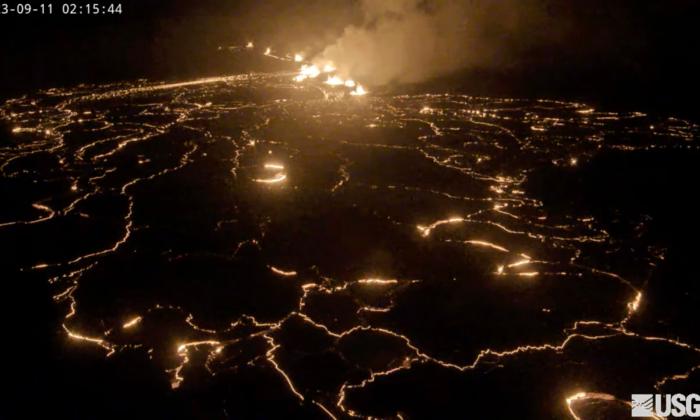Another eruption has been detected at the Kilauea volcano on Hawaii’s Big Island, with the situation prompting the U.S. Geological Survey (USGS) to elevate its volcanic alert level from “watch” to “warning.”
This is the third eruption of the Kilauea—“much spreading” in Hawaiian—volcano this year, following eruptions in January and June.
The volcanic eruption was observed at about 3:15 p.m. local time on Sept. 10. The USGS Hawaiian Volcano Observatory (HVO) stated that it began within the Halemaʻumaʻu crater and “on the down dropped block to the east in Kilauea’s summit caldera,” which is within Hawaii Volcanoes National Park.

According to the USGS, the eruption was preceded by “a period of strong seismicity” and “rapid uplift of the summit.” The eruption activity is confined entirely within the park, which is away from any residential areas.
The USGS stated that it raised the volcano alert level from “watch” to “warning” and changed its aviation color code from “orange” to “red”—which means that a major volcanic eruption is either imminent or suspected with hazardous activity both on the ground and in the air.
“The activity is confined to Halemaʻumaʻu, and the hazards will be reassessed as the eruption progresses,” the USGS stated, noting that the HVO is in constant communication with the national park regarding the situation.
Hawaii’s Emergency Management Agency (EMA) stated that the eruption doesn’t pose a lava threat to nearby communities.
Kilauea, Hawaii’s second-largest volcano, erupted from September 2021 until December 2022. For about two weeks in December 2022, Hawaii’s biggest volcano, Mauna Loa, also was erupting on Hawaii’s Big Island.
After a short pause, Kilauea began erupting again in January. That eruption lasted for 61 days, ending in March. The volcano erupted for a second time in June, displaying fountains of glowing red lava without threatening any communities; that eruption lasted less than two weeks.

During the second eruption, visitors to Hawaii Volcanoes National Park were able to see the eruption from many viewing points.
“Kilauea overlook was spectacular this morning,” park spokesperson Jessica Ferracane said of the vast lava lake on June 7. “It was molten red lava. There’s several areas of pretty robust fountaining. It’s just really, really pretty.”
A 2018 Kilauea eruption destroyed more than 700 homes. Before that major eruption, Kilauea had been erupting since 1983, and streams of lava occasionally affected farms and homes. During that time, the lava sometimes reached the ocean, causing dramatic interactions with the water.
In 2019, a string of earthquakes and major eruptions at Kilauea led to the destruction of hundreds of homes and businesses.







